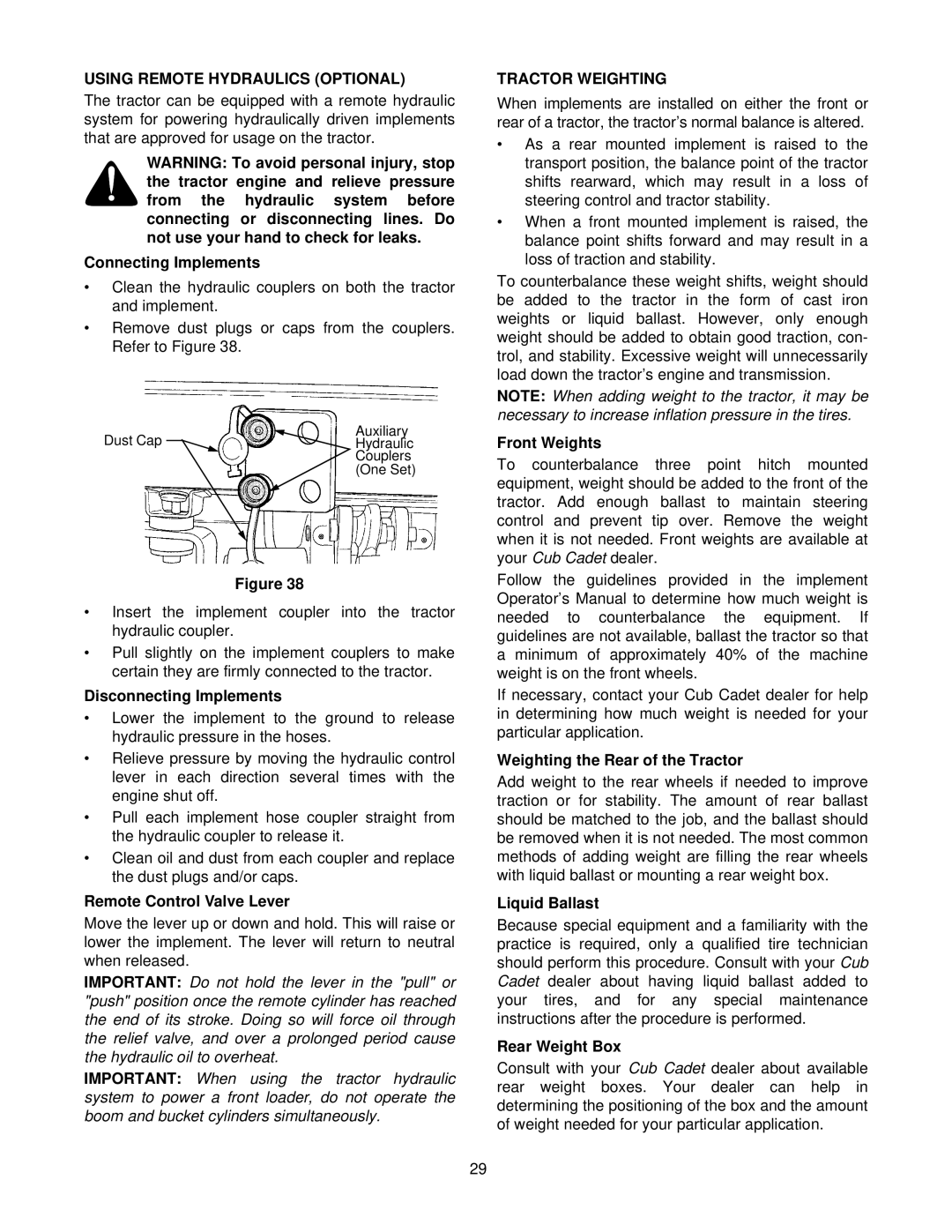
USING REMOTE HYDRAULICS (OPTIONAL)
The tractor can be equipped with a remote hydraulic system for powering hydraulically driven implements that are approved for usage on the tractor.
WARNING: To avoid personal injury, stop the tractor engine and relieve pressure from the hydraulic system before connecting or disconnecting lines. Do not use your hand to check for leaks.
Connecting Implements
•Clean the hydraulic couplers on both the tractor and implement.
•Remove dust plugs or caps from the couplers. Refer to Figure 38.
Dust Cap |
| Auxiliary |
| Hydraulic | |
| ||
|
| Couplers |
|
| (One Set) |
Figure 38
•Insert the implement coupler into the tractor hydraulic coupler.
•Pull slightly on the implement couplers to make certain they are firmly connected to the tractor.
Disconnecting Implements
•Lower the implement to the ground to release hydraulic pressure in the hoses.
•Relieve pressure by moving the hydraulic control lever in each direction several times with the engine shut off.
•Pull each implement hose coupler straight from the hydraulic coupler to release it.
•Clean oil and dust from each coupler and replace the dust plugs and/or caps.
Remote Control Valve Lever
Move the lever up or down and hold. This will raise or lower the implement. The lever will return to neutral when released.
IMPORTANT: Do not hold the lever in the "pull" or "push" position once the remote cylinder has reached the end of its stroke. Doing so will force oil through the relief valve, and over a prolonged period cause the hydraulic oil to overheat.
IMPORTANT: When using the tractor hydraulic system to power a front loader, do not operate the boom and bucket cylinders simultaneously.
TRACTOR WEIGHTING
When implements are installed on either the front or rear of a tractor, the tractor’s normal balance is altered.
•As a rear mounted implement is raised to the transport position, the balance point of the tractor shifts rearward, which may result in a loss of steering control and tractor stability.
•When a front mounted implement is raised, the balance point shifts forward and may result in a loss of traction and stability.
To counterbalance these weight shifts, weight should be added to the tractor in the form of cast iron weights or liquid ballast. However, only enough weight should be added to obtain good traction, con- trol, and stability. Excessive weight will unnecessarily load down the tractor’s engine and transmission.
NOTE: When adding weight to the tractor, it may be necessary to increase inflation pressure in the tires.
Front Weights
To counterbalance three point hitch mounted equipment, weight should be added to the front of the tractor. Add enough ballast to maintain steering control and prevent tip over. Remove the weight when it is not needed. Front weights are available at your Cub Cadet dealer.
Follow the guidelines provided in the implement Operator’s Manual to determine how much weight is needed to counterbalance the equipment. If guidelines are not available, ballast the tractor so that a minimum of approximately 40% of the machine weight is on the front wheels.
If necessary, contact your Cub Cadet dealer for help in determining how much weight is needed for your particular application.
Weighting the Rear of the Tractor
Add weight to the rear wheels if needed to improve traction or for stability. The amount of rear ballast should be matched to the job, and the ballast should be removed when it is not needed. The most common methods of adding weight are filling the rear wheels with liquid ballast or mounting a rear weight box.
Liquid Ballast
Because special equipment and a familiarity with the practice is required, only a qualified tire technician should perform this procedure. Consult with your Cub Cadet dealer about having liquid ballast added to your tires, and for any special maintenance instructions after the procedure is performed.
Rear Weight Box
Consult with your Cub Cadet dealer about available rear weight boxes. Your dealer can help in determining the positioning of the box and the amount of weight needed for your particular application.
29
